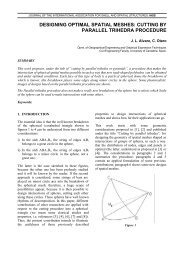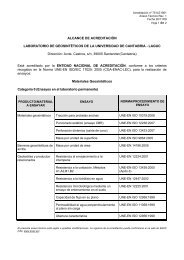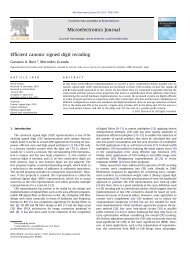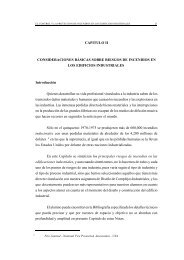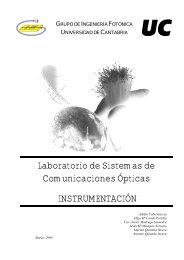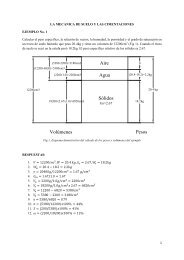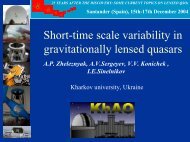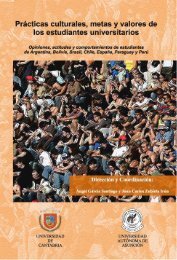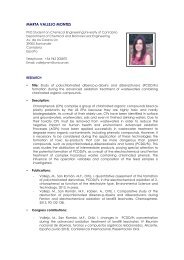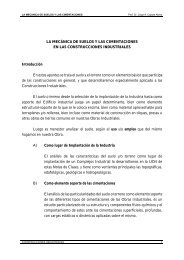XXXVII <str<strong>on</strong>g>IAHS</str<strong>on</strong>g><str<strong>on</strong>g>World</str<strong>on</strong>g> <str<strong>on</strong>g>C<strong>on</strong>gress</str<strong>on</strong>g> <strong>on</strong> <strong>Housing</strong>October 26 – 29, 2010, Santan<strong>de</strong>r, SpainCODE: 130THE INVESTIGATION OF RESISTIBILITY OF CEMENTCOMPOSITES AGAINST BIOLOGICAL ACTIVITYEstokova, A. 1 , Ondrejka Harbulakova, V. 1 , Luptakova, A. 2 , Prascakova, M. 2 , Stevulova, N. 11 Institute of Building and Envir<strong>on</strong>mental EngineeringFaculty of Civil Engineering, Technical University of Kosice, Slovak Republice-mail: adriana.estokova@tuke.sk2 Institute of GeotechnicsSlovak Aca<strong>de</strong>my of Science, Slovak Republice-mail: luptakal@saske.skKey words: c<strong>on</strong>crete, MIC, bacteria, biocorrosi<strong>on</strong>, bio<strong>de</strong>teriorati<strong>on</strong>.AbstractThe role of bacteria causing the c<strong>on</strong>crete <strong>de</strong>teriorati<strong>on</strong> has been linked to the generati<strong>on</strong> ofbiogenic sulphuric and nitric acids resulting in corrosi<strong>on</strong> process by dissoluti<strong>on</strong> of calciumc<strong>on</strong>taining minerals from the c<strong>on</strong>crete matrices. The start and the course of corrosi<strong>on</strong> arec<strong>on</strong>diti<strong>on</strong>ed by many factors which undoubtedly inclu<strong>de</strong> biological effects like the influenceof vegetati<strong>on</strong> and microorganisms causing the so called microbial corrosi<strong>on</strong>.This paper is primarily c<strong>on</strong>cerned with investigati<strong>on</strong> of influence of sulphur-oxidisingbacteria Acidithiobacillus thiooxidans and sulphate-reducing bacteria Desulfovibrio<strong>de</strong>sulfuricans at the resistance <strong>de</strong>gree of cement composites. Cement composite samples with5 % additi<strong>on</strong> of black coal fly ash as cement replacement as well as reference samples withoutcoal fly ash additi<strong>on</strong> were investigated in experiments. The laboratory experiments as well asexperiments in situ in sewage system procee<strong>de</strong>d during 90 days.The penetrati<strong>on</strong> of the corrosi<strong>on</strong> was manifested by surface changes and weight changes ofcement composites samples as well as changes in pH values. C<strong>on</strong>si<strong>de</strong>rable surface changeswere <strong>de</strong>tected for all investigated samples by microscopic methods. The roughness increaseswere <strong>de</strong>termined by c<strong>on</strong>focal laser scanning microscopy. Crystals precipitated <strong>on</strong> c<strong>on</strong>cretesamples surface were i<strong>de</strong>ntified by EDX as mixture of gypsum and ettringite.37º <str<strong>on</strong>g>IAHS</str<strong>on</strong>g> <str<strong>on</strong>g>World</str<strong>on</strong>g> <str<strong>on</strong>g>C<strong>on</strong>gress</str<strong>on</strong>g> On <strong>Housing</strong> Science 77
XXXVII <str<strong>on</strong>g>IAHS</str<strong>on</strong>g><str<strong>on</strong>g>World</str<strong>on</strong>g> <str<strong>on</strong>g>C<strong>on</strong>gress</str<strong>on</strong>g> <strong>on</strong> <strong>Housing</strong>October 26 – 29, 2010, Santan<strong>de</strong>r, SpainCODE: 131CONCRETES OF HIGHER RESISTANCE TO CHEMICALACTIONSSicakova, A., Terpakova, E.Institute of Building and Envir<strong>on</strong>mental EngineeringCivil Engineering Faculty, Technical University of Kosicee-mail: alena.sicakova@tuke.skKey words: c<strong>on</strong>crete, chemical aggressive envir<strong>on</strong>ment, mineral additive, blast furnace slag, fly ash,serpentiniteAbstractIn the paper the results of experimental works aimed <strong>on</strong> finding the optimal compositi<strong>on</strong> ofc<strong>on</strong>cretes c<strong>on</strong>taining various mineral additives for assurance their high resistance to chemicalaggressive attacks are presented. 16 recipes using variati<strong>on</strong>s of: 4 kinds of wastes/additives(blast furnace slag, fly ash, n<strong>on</strong>-treated and treated serpentinite waste), 3 kinds of their dosage(0, 10, 20% of cement amount), as well as alternative superplasticizer applicati<strong>on</strong> (0, 1% ofcement amount) were tested. Samples were exposed to chemical aggressive envir<strong>on</strong>ments(HCl, MgSO 4 and NaOH) for simulati<strong>on</strong> of c<strong>on</strong>crete corrosive processes. The distilled wateras well as open laboratory envir<strong>on</strong>ment was used as a comparative envir<strong>on</strong>ments. Durati<strong>on</strong> ofc<strong>on</strong>crete samples expositi<strong>on</strong> in tested media was 28 m<strong>on</strong>ths. The resistance was tested in theterms of flexural strength, compressive strength and evaluati<strong>on</strong> of <strong>de</strong>crease/increase ofstrengths after l<strong>on</strong>g time acti<strong>on</strong> of m<strong>on</strong>itored aggressive media.For each aggressive envir<strong>on</strong>ment is possible to recommend the most promising recipe ofc<strong>on</strong>crete from various points of view, in accordance with user´s priorities.From the percentage increase of 28- day compressive strengths point of view, there are: forHCl acti<strong>on</strong> – recipe with 20% of n<strong>on</strong> treated serpentinite waste with plasticizer applicati<strong>on</strong>,for MgSO 4 acti<strong>on</strong> -recipe with 20% of blast furnace slag without plasticizer applicati<strong>on</strong> and for NaOH acti<strong>on</strong> -recipe with 10% of n<strong>on</strong> treated serpentinite waste without plasticizer applicati<strong>on</strong>.Based <strong>on</strong> the presented experimental results, applicati<strong>on</strong> of additives/wastes as partialsubstituti<strong>on</strong> of cement appears to be beneficial for achievement the resistance to aggressivechemical acti<strong>on</strong>s. With the keeping or enhancement of technical parameters it especiallyrepresents both the envir<strong>on</strong>mental and ec<strong>on</strong>omic benefit.37º <str<strong>on</strong>g>IAHS</str<strong>on</strong>g> <str<strong>on</strong>g>World</str<strong>on</strong>g> <str<strong>on</strong>g>C<strong>on</strong>gress</str<strong>on</strong>g> On <strong>Housing</strong> Science 78
- Page 1 and 2:
University ofCantabriawww.iahshousi
- Page 3 and 4:
ÍNDICE1. HONORARY COMMITTEE ______
- Page 5 and 6:
2. INTRODUCTIONThe International As
- Page 7:
4. ENTIDADES COLABORADORASColegio d
- Page 10 and 11:
6. ORGANIZING COMMITTEELOCAL ORGANI
- Page 12 and 13:
8. TOPICS - STATISTICSTOPIC I: MATE
- Page 14 and 15:
also the Spanish aristocracy used t
- Page 16 and 17:
11. CONFERENCE ROOMSThe Con
- Page 18 and 19:
Also, the Congress
- Page 20 and 21:
13. PLENARY SESSIONSPLENARY SESSION
- Page 22 and 23:
October 26, 9 h 30-10 h 00 (Room 0)
- Page 24 and 25:
October 26, 10 h 30-11 h 00 (Room 0
- Page 26 and 27:
October 27, 9 h 30-10 h 00 (Room 0)
- Page 28 and 29:
October 27, 10 h 30-11 h 00 (Room 0
- Page 30 and 31: October 28, 9 h 30-10 h 00 (Room 0)
- Page 32 and 33: October 28, 10 h 30-11 h 00 (Room 0
- Page 34 and 35: October 26, 201011 h 30-13 h 30 Cha
- Page 36 and 37: October 26, 201011 h 30-13 h 30 Cha
- Page 38 and 39: October 27, 201011 h 30-13 h 30 Cha
- Page 40 and 41: October 27, 201011 h 30-13 h 30 Cha
- Page 42 and 43: October 28, 201011 h 30-13 h 30 Cha
- Page 44 and 45: October 28, 201011 h 30-13 h 30 Cha
- Page 46 and 47: 16. TECHNICAL EXPOSITION (STANDS)37
- Page 48 and 49: TRIP A: MARITIME MUSEUM + PEDREÑA
- Page 50 and 51: RECEPTION COCKTAIL BY THE MAYOR OFS
- Page 52 and 53: 37º IAHS
- Page 54 and 55: GALA DINNERDía 28 de OctubrePassin
- Page 56 and 57: 37º IAHS
- Page 58 and 59: 19. ABSTRACTS OF THE CONGRESSABSTRA
- Page 60 and 61: XXXVII IAHS<strong
- Page 62 and 63: XXXVII IAHS<strong
- Page 64 and 65: XXXVII IAHS<strong
- Page 66 and 67: XXXVII IAHS<strong
- Page 71 and 72: XXXVII IAHS<strong
- Page 73 and 74: XXXVII IAHS<strong
- Page 75 and 76: XXXVII IAHS<strong
- Page 77 and 78: XXXVII IAHS<strong
- Page 79: XXXVII IAHS<strong
- Page 83 and 84: XXXVII IAHS<strong
- Page 85 and 86: XXXVII IAHS<strong
- Page 87 and 88: XXXVII IAHS<strong
- Page 89 and 90: XXXVII IAHS<strong
- Page 91 and 92: XXXVII IAHS<strong
- Page 93 and 94: XXXVII IAHS<strong
- Page 95 and 96: XXXVII IAHS<strong
- Page 97 and 98: XXXVII IAHS<strong
- Page 99 and 100: XXXVII IAHS<strong
- Page 101 and 102: XXXVII IAHS<strong
- Page 103 and 104: XXXVII IAHS<strong
- Page 105 and 106: XXXVII IAHS<strong
- Page 107 and 108: XXXVII IAHS<strong
- Page 109 and 110: XXXVII IAHS<strong
- Page 111 and 112: XXXVII IAHS<strong
- Page 113 and 114: XXXVII IAHS<strong
- Page 115 and 116: XXXVII IAHS<strong
- Page 117 and 118: XXXVII IAHS<strong
- Page 119 and 120: XXXVII IAHS<strong
- Page 121 and 122: XXXVII IAHS<strong
- Page 123 and 124: XXXVII IAHS<strong
- Page 125 and 126: XXXVII IAHS<strong
- Page 127 and 128: XXXVII IAHS<strong
- Page 129 and 130: XXXVII IAHS<strong
- Page 131 and 132:
XXXVII IAHS<strong
- Page 133 and 134:
XXXVII IAHS<strong
- Page 135 and 136:
XXXVII IAHS<strong
- Page 137 and 138:
XXXVII IAHS<strong
- Page 139 and 140:
XXXVII IAHS<strong
- Page 141 and 142:
XXXVII IAHS<strong
- Page 143 and 144:
XXXVII IAHS<strong
- Page 145 and 146:
XXXVII IAHS<strong
- Page 147 and 148:
XXXVII IAHS<strong
- Page 149 and 150:
XXXVII IAHS<strong
- Page 151 and 152:
XXXVII IAHS<strong
- Page 153 and 154:
XXXVII IAHS<strong
- Page 155 and 156:
XXXVII IAHS<strong
- Page 157 and 158:
XXXVII IAHS<strong
- Page 159 and 160:
XXXVII IAHS<strong
- Page 161 and 162:
XXXVII IAHS<strong
- Page 163 and 164:
XXXVII IAHS<strong
- Page 165 and 166:
XXXVII IAHS<strong
- Page 167 and 168:
XXXVII IAHS<strong
- Page 169 and 170:
XXXVII IAHS<strong
- Page 171 and 172:
XXXVII IAHS<strong
- Page 173 and 174:
XXXVII IAHS<strong
- Page 175 and 176:
XXXVII IAHS<strong
- Page 177 and 178:
XXXVII IAHS<strong
- Page 179 and 180:
XXXVII IAHS<strong
- Page 181 and 182:
XXXVII IAHS<strong
- Page 183 and 184:
XXXVII IAHS<strong
- Page 185 and 186:
XXXVII IAHS<strong
- Page 187 and 188:
XXXVII IAHS<strong
- Page 189 and 190:
XXXVII IAHS<strong
- Page 191 and 192:
XXXVII IAHS<strong
- Page 193 and 194:
XXXVII IAHS<strong
- Page 195 and 196:
XXXVII IAHS<strong
- Page 197 and 198:
TOPIC IV - HEALTH, COMFORT AND SAFE
- Page 199 and 200:
XXXVII IAHS<strong
- Page 201 and 202:
XXXVII IAHS<strong
- Page 203 and 204:
XXXVII IAHS<strong
- Page 205 and 206:
XXXVII IAHS<strong
- Page 207 and 208:
XXXVII IAHS<strong
- Page 209 and 210:
XXXVII IAHS<strong
- Page 211 and 212:
XXXVII IAHS<strong
- Page 213 and 214:
XXXVII IAHS<strong
- Page 215 and 216:
XXXVII IAHS<strong
- Page 217 and 218:
XXXVII IAHS<strong
- Page 219 and 220:
XXXVII IAHS<strong
- Page 221 and 222:
XXXVII IAHS<strong
- Page 223 and 224:
XXXVII IAHS<strong
- Page 225 and 226:
XXXVII IAHS<strong
- Page 227 and 228:
XXXVII IAHS<strong
- Page 229 and 230:
XXXVII IAHS<strong
- Page 231 and 232:
XXXVII IAHS<strong
- Page 233 and 234:
XXXVII IAHS<strong
- Page 235 and 236:
TOPIC VI - URBAN AND CITY PLANNING.
- Page 237 and 238:
XXXVII IAHS<strong
- Page 239 and 240:
XXXVII IAHS<strong
- Page 241 and 242:
XXXVII IAHS<strong
- Page 243 and 244:
XXXVII IAHS<strong
- Page 245 and 246:
XXXVII IAHS<strong
- Page 247 and 248:
XXXVII IAHS<strong
- Page 249 and 250:
XXXVII IAHS<strong
- Page 251 and 252:
XXXVII IAHS<strong
- Page 253 and 254:
XXXVII IAHS<strong
- Page 255 and 256:
XXXVII IAHS<strong
- Page 257 and 258:
XXXVII IAHS<strong
- Page 259 and 260:
XXXVII IAHS<strong
- Page 261 and 262:
XXXVII IAHS<strong
- Page 263 and 264:
XXXVII IAHS<strong
- Page 265 and 266:
TOPIC VII - ECONOMY AND FINANCING P
- Page 267 and 268:
XXXVII IAHS<strong
- Page 269 and 270:
XXXVII IAHS<strong
- Page 271 and 272:
XXXVII IAHS<strong
- Page 273 and 274:
TOPIC VIII - MANAGEMENT SCHEMES AND
- Page 275 and 276:
XXXVII IAHS<strong
- Page 277 and 278:
XXXVII IAHS<strong
- Page 279 and 280:
XXXVII IAHS<strong
- Page 281 and 282:
XXXVII IAHS<strong
- Page 283 and 284:
XXXVII IAHS<strong
- Page 285 and 286:
XXXVII IAHS<strong
- Page 287 and 288:
XXXVII IAHS<strong
- Page 289 and 290:
XXXVII IAHS<strong
- Page 291 and 292:
XXXVII IAHS<strong
- Page 293 and 294:
XXXVII IAHS<strong
- Page 295 and 296:
XXXVII IAHS<strong
- Page 297 and 298:
XXXVII IAHS<strong
- Page 299 and 300:
XXXVII IAHS<strong
- Page 301 and 302:
XXXVII IAHS<strong
- Page 303 and 304:
XXXVII IAHS<strong
- Page 305 and 306:
XXXVII IAHS<strong
- Page 307 and 308:
XXXVII IAHS<strong
- Page 309 and 310:
XXXVII IAHS<strong
- Page 311 and 312:
XXXVII IAHS<strong
- Page 313 and 314:
XXXVII IAHS<strong
- Page 315 and 316:
XXXVII IAHS<strong
- Page 317 and 318:
XXXVII IAHS<strong
- Page 319 and 320:
XXXVII IAHS<strong
- Page 321 and 322:
XXXVII IAHS<strong
- Page 323 and 324:
XXXVII IAHS<strong
- Page 325 and 326:
XXXVII IAHS<strong
- Page 327 and 328:
XXXVII IAHS<strong
- Page 329 and 330:
XXXVII IAHS<strong
- Page 331 and 332:
XXXVII IAHS<strong
- Page 333 and 334:
XXXVII IAHS<strong
- Page 335 and 336:
XXXVII IAHS<strong
- Page 337 and 338:
XXXVII IAHS<strong
- Page 339 and 340:
XXXVII IAHS<strong
- Page 341 and 342:
XXXVII IAHS<strong
- Page 343 and 344:
XXXVII IAHS<strong
- Page 345 and 346:
XXXVII IAHS<strong
- Page 347 and 348:
XXXVII IAHS<strong
- Page 349 and 350:
XXXVII IAHS<strong
- Page 351 and 352:
XXXVII IAHS<strong
- Page 353 and 354:
XXXVII IAHS<strong
- Page 355 and 356:
XXXVII IAHS<strong
- Page 357 and 358:
XXXVII IAHS<strong
- Page 359 and 360:
XXXVII IAHS<strong
- Page 361 and 362:
XXXVII IAHS<strong
- Page 363 and 364:
XXXVII IAHS<strong
- Page 365 and 366:
XXXVII IAHS<strong
- Page 367 and 368:
XXXVII IAHS<strong
- Page 369 and 370:
XXXVII IAHS<strong
- Page 371 and 372:
XXXVII IAHS<strong
- Page 373 and 374:
XXXVII IAHS<strong
- Page 375 and 376:
XXXVII IAHS<strong
- Page 377 and 378:
XXXVII IAHS<strong



